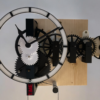Driving the Internet: Mobile Internets, Cars, and the Social
Characteristics of Heavily Edited Objects in OpenStreetMap
Abstract
This paper describes the results of an analysis of the OpenStreetMap (OSM) database for the United Kingdom (UK) and Ireland (correct to April 2011). 15; 640 OSM ways (polygons and polylines), resulting in 316; 949 unique versions of these objects, were extracted and analysed from the OSM database for the UK and Ireland.
In our analysis we only considered “heavily edited” objects in OSM: objects which have been edited 15 or more times. Our results show that there is no strong relationship between increasing numbers of contributors to a given object and the number of tags (metadata) assigned to it. 87% of contributions/edits to these objects are performed by 11% of the total 4128 contributors.
In 79% of edits additional spatial data (nodes) are added to objects. The results in this paper do not attempt to evaluate the OSM data as good/poor quality but rather informs potential consumers of OSM data that the data itself is changing over time. In developing a better understanding of the characteristics of “heavily edited” objects there may be opportunities to use historical analysis in working towards quality indicators for OSM in the future.
As ever with Future Internet the paper is freely available for download…
Characteristics of Heavily Edited Objects in OpenStreetMap
Abstract
This paper describes the results of an analysis of the OpenStreetMap (OSM) database for the United Kingdom (UK) and Ireland (correct to April 2011). 15; 640 OSM ways (polygons and polylines), resulting in 316; 949 unique versions of these objects, were extracted and analysed from the OSM database for the UK and Ireland.
In our analysis we only considered “heavily edited” objects in OSM: objects which have been edited 15 or more times. Our results show that there is no strong relationship between increasing numbers of contributors to a given object and the number of tags (metadata) assigned to it. 87% of contributions/edits to these objects are performed by 11% of the total 4128 contributors.
In 79% of edits additional spatial data (nodes) are added to objects. The results in this paper do not attempt to evaluate the OSM data as good/poor quality but rather informs potential consumers of OSM data that the data itself is changing over time. In developing a better understanding of the characteristics of “heavily edited” objects there may be opportunities to use historical analysis in working towards quality indicators for OSM in the future.
As ever with Future Internet the paper is freely available for download…
Over the past few days we have been working on a series of techniques to visualise and augment procedural cities.
If you add in a model of a BenQ projector, the MRes in Advanced Spatial Analysis and Visualisation Handbook, a city within the CASA logo and a webcam you get the following augmented reality:
We are exploring this as part of our digital visualisation module on the MRes here in CASA, aiming to build in the latest research into the lectures. The combination of Lumion, 3DMax, Illustrator, CityEngine and AR is intriguing…



